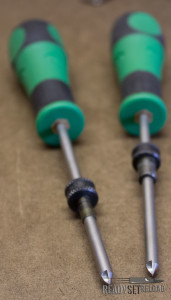Chamfering, Deburring and Primer Pocket Cleaning
In this post I’ll be talking about chamfering, deburring and primer pocket cleaning. I’ll show you how to clean the rest of the carbon from the primer pocket which is left over from the tumbling process. This step is required so when you seat the bullet in a case the trimmed edges on the brass won’t gouge into it.

RCBS Handle that can be used for the Primer Pocket Cleaning Tool
After you’ve completed the trimming process the sides of the brass will be sharp. There are many tools on the market to accomplish this task but I went the cheaper route and selected a manual tool versus an automatic tool because the process didn’t look as monotonous as some of the others. By using a tool such as the Lyman Case Prep Multi Tool, you can remove these edges allowing for a properly prepared mouth to insert the bullet into. In the future I may purchase an automatic tool but this works great for the volume that I reload at once.

Primer Pocket Cleaning Bit
Using the tool is simple. Spin each end of the tool in the case mouth a few times and it will remove a small amount of material. It’s really that easy. After a few hundred pieces of brass I found that I could lay the tool down on the bench and roll it back and forth with one hand while holding a piece of brass in the other hand (like shown in the video above). Once you’ve completed this processes you will be able to notice a difference between freshly trimmed brass both noticeably and by touch.
The final process in brass preparation is to remove the remaining carbon from the primer pocket. In part 2e of this series I talked about removing the primers from your brass then running them through the tumbler one last time to help clean the primer pocket. By doing that, it makes this step much easier to complete since most of the work has been done for you already. Included with the Lyman Case Prep Tool is a Primer Pocket Cleaning Bit. I screw this into a RCBS handle to make this a little more efficient during this processes so I don’t have to switch bits; its a little more ergonomic than the Lyman tool in my opinion. Insert the bit into the primer pocket and spin repeatedly until the carbon is removed. In most cases you won’t be able to remove all of the carbon but the majority of it will be scraped out during this processes.

Lyman Case Prep Multi Tool
This is the end of the brass preparation phase; the hard work is done. In the next phase we will be priming live primers into the brass that you’ve just prepared.
Equipment discussed in this section:
Note: I use the handle of the deburring tool with the primer pocket cleaning bit included in the Lyman Case Prep Multi Tool

